Heidelberg is a historic city in the state of Baden-Württemberg in the southwest of Germany. Heidelberg University was founded in 1386, which makes it Germany’s Oldest University! Besides, about a quarter of the population are students.
In 1907, a jawbone fossil, that’s about 610,000 years old, was found near Heidelberg. It was from a species called Homo Heidelbergensis, an ancestor of modern humans. From the 5th century BC, this region was inhabited by Celtics, and later by the Romans and Germanic tribes.
Many tourists come to Heidelberg thanks to its iconic attractions, which include Heidelberg Castle, the German Pharmacy Museum, Königstuhl Viewpoint, the historic Old Town district, the Old Bridge, and some cool museums!
I went to Heidelberg for a day trip in June 2024 and loved it! So I hope that this guide about The Best Things to Do in One Day in Heidelberg, Germany will make you sing I Lost my Heart in Heidelberg** for the rest of your life!
Disclosure: I only recommend products that I’ve used in the past, and all opinions expressed in this post are my own. This post contains affiliate links. If you use one of the links throughout the page to buy something, I may earn a small commission at no extra cost to you. Thank you!
Explore Schloss Heidelberg (Heidelberg Castle)
Address: Schlosshof 1, 69117 Heidelberg, Germany
Let’s start with Heidelberg’s #1 attraction, the famous Schloss Heidelberg! It sits proudly on a hill and overlooks the city and the surrounding Neckar valley.
Schloss Heidelberg was first completed as a fortress in 1214 and palace buildings were added in the 15th and 16th century. The Palatine Counts and Electors from the House of Wittelsbach lived here and ruled the Heidelberg region for more than 400 years.
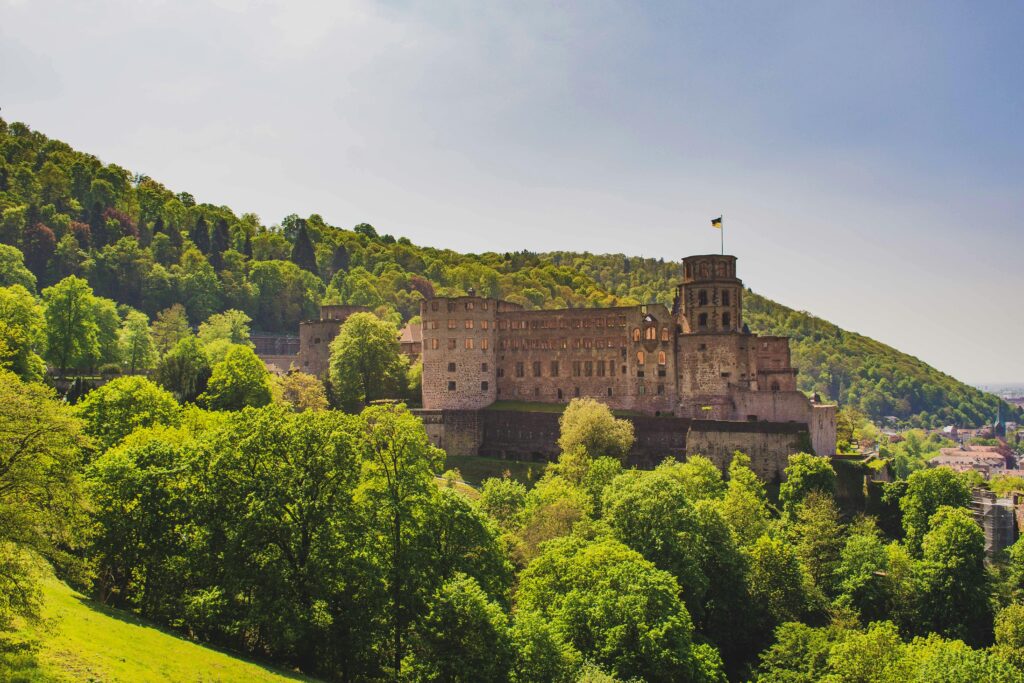
Schloss Heidelberg was damaged repeatedly during the Thirty Years’ War and the Nine Years’ War in the 17th century. Later, in 1764, it caught fire because of getting struck by lightning twice, which left it in ruins. These ruins were only partially rebuilt afterwards and the previous owners moved away.
Since the 19th century, the ruins of Schloss Heidelberg have been a symbol of the German Romanticism Movement, inspiring painters, writers, and other artists with their raw beauty. So Schloss Heidelberg became a national monument soon after.
Today the castle complex is famous for its impressive red sandstone ruins, the palace buildings (e.g. Friedrichsbau (Friedrich’s Wing)) in the courtyard, the annual Heidelberger Schlossfestspiele festival, and panoramic views of Heidelberg and the Neckar valley from the terrace.
The castle ruins are the most visited ruins in Germany.
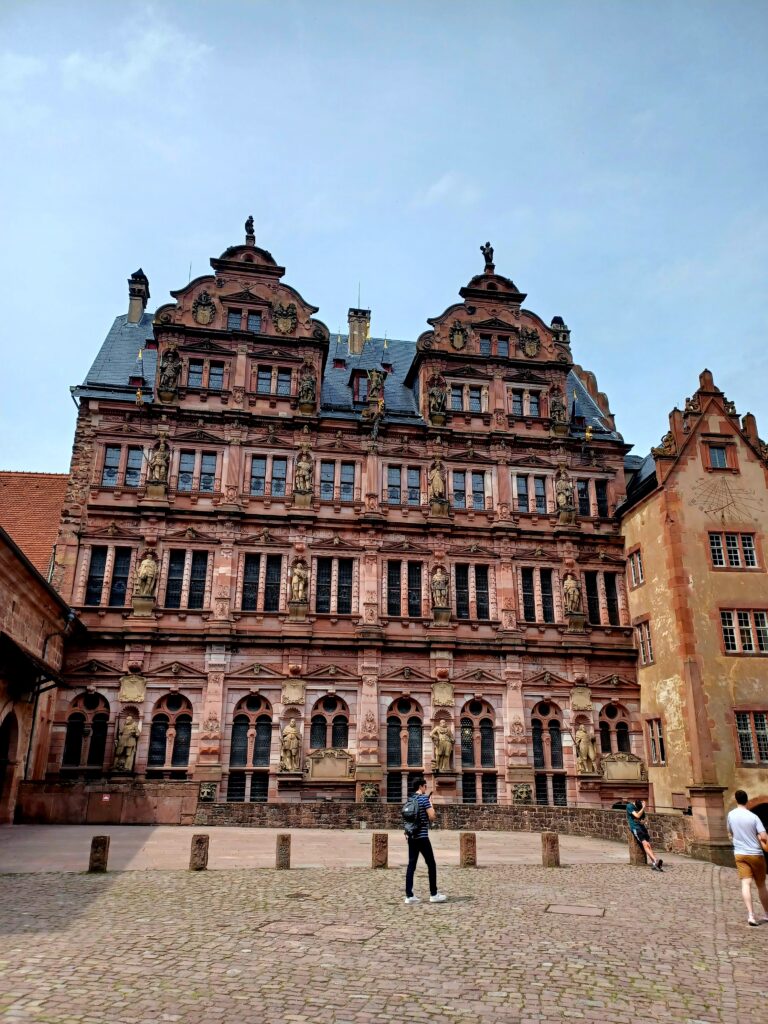
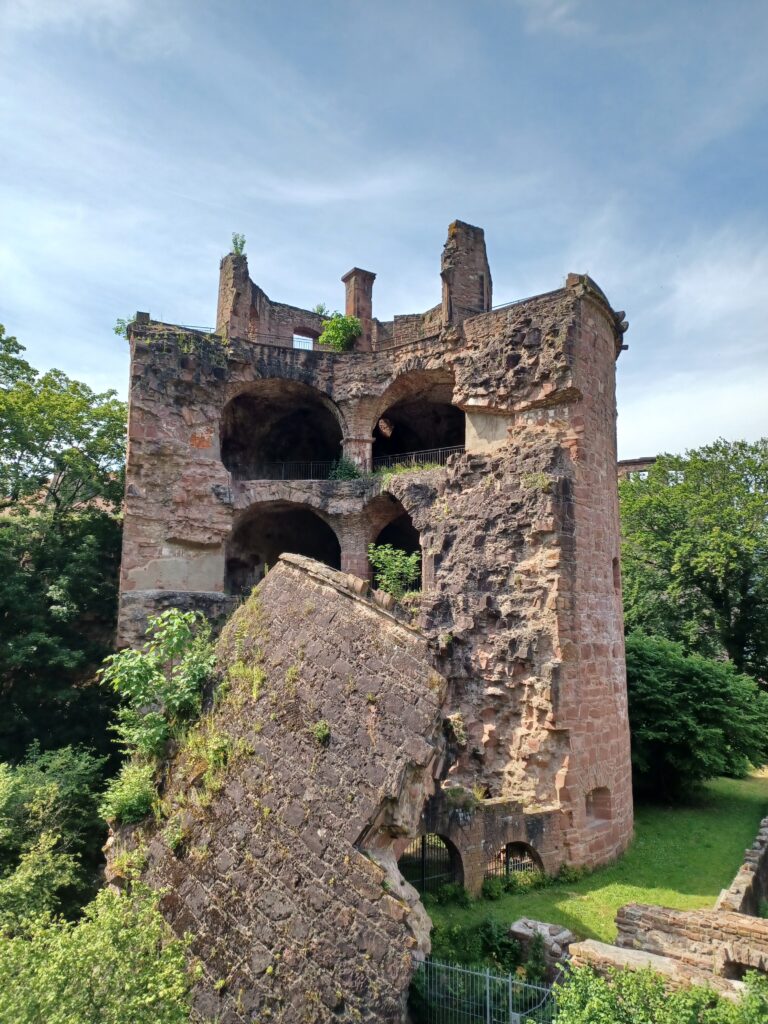
The Friedrichsbau building and the Gesprengte Turm (exploded tower) ruin from 1693.
There are two options on how to get from Heidelberg’s Altstadt (Old Town) to Schloss Heidelberg. You can walk up within 15 minutes (it’s quite steep) or take the Bergbahn (funicular) from Kornmarkt station to Schloss station.
The Schlossticket (castle ticket) admission is 9 EUR (roundtrip). Entry to the Heidelberg Tun, German Apothecary Museum, and the garden is included, which we’ll cover next. Guided tours of the castle complex are also available.
Schloss Heidelberg is open daily from 9 am to 6 pm (except December 25th). Hours are shorter on December 24th and 31st and January 1st.
Check out the Großes Fass (Heidelberg Tun)
If you enter Schloss Heidelberg’s Barrel Building cellar, you cannot miss the massive Heidelberg Tun. At 7 meters (22 ft) high and 8.5 meters (27 ft) wide, it’s the World’s Largest Wine Barrel!
The original Heidelberg Tun from 1591 was destroyed in the Thirty Years’ War and two more followed. The fourth (current) barrel replaced them in 1751 and could carry up to 220,000 liters of wine!
Visitors can walk up to the top of the barrel that most likely was used as a dancefloor in earlier times.
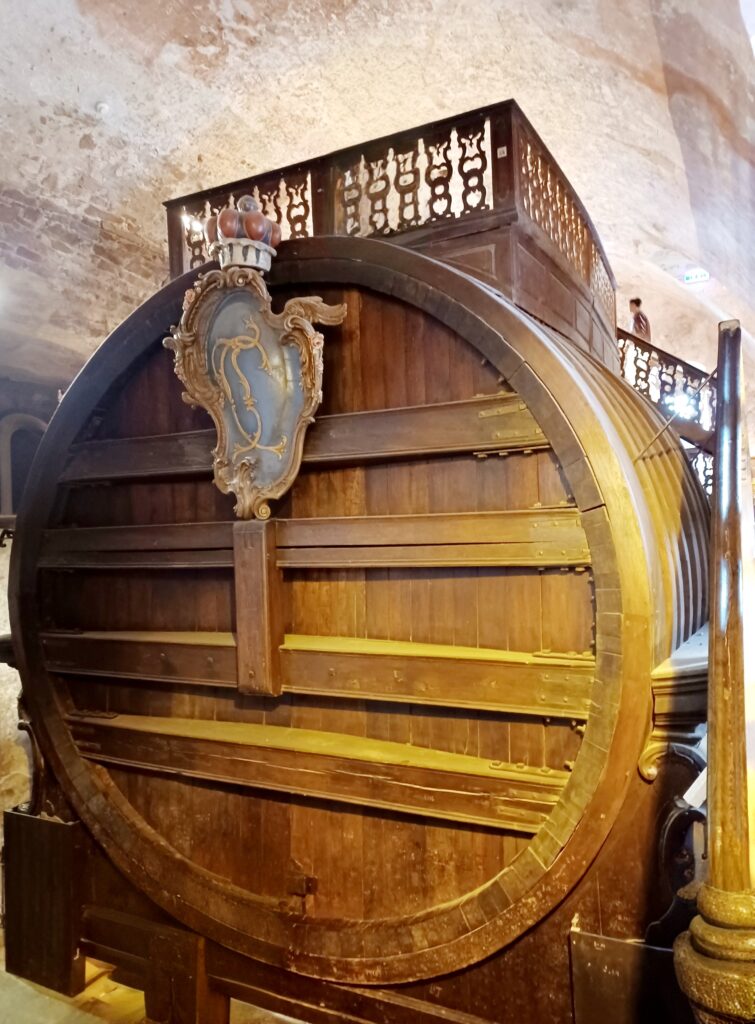
Deutsches Apothekenmuseum (German Apothecary Museum)
Another highlight within the castle complex is the epic Deutsches Apothekenmuseum. Here visitors can learn about pharmaceutics and medical science history from the antiquity to the 21st century. It has eleven rooms and 20,000 pieces of medication on display.
The most fascinating part of this exhibit are the perfectly preserved apothecary workrooms (officina) from the 17th to the 19th century. Some pharmacies were a part of monasteries, while others were inside Baroque-style buildings in towns or cities.
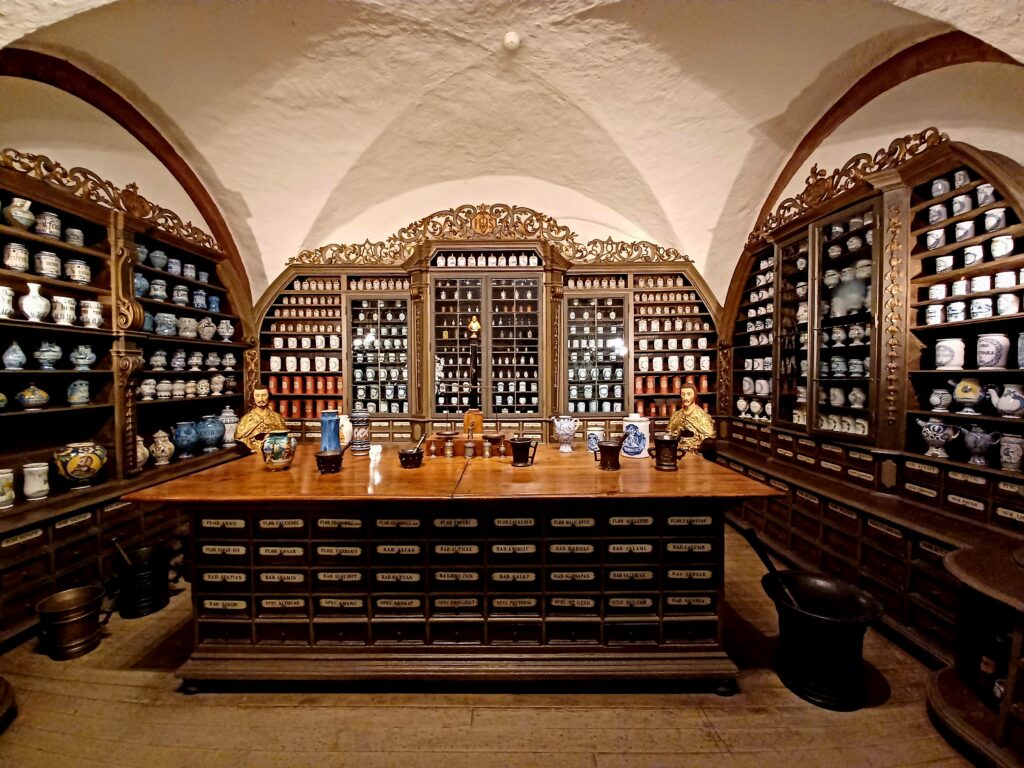
Another cool feature of the exhibit are the medicaments used back then, including arsenic, opium, animal fragrances, plant roots, fresh herbs, and even pulverized mummy!
There’s also a large bronze mortar of the Zorn’sche Pharmacy in Berlin from 1638 that played a crucial role in medication production.

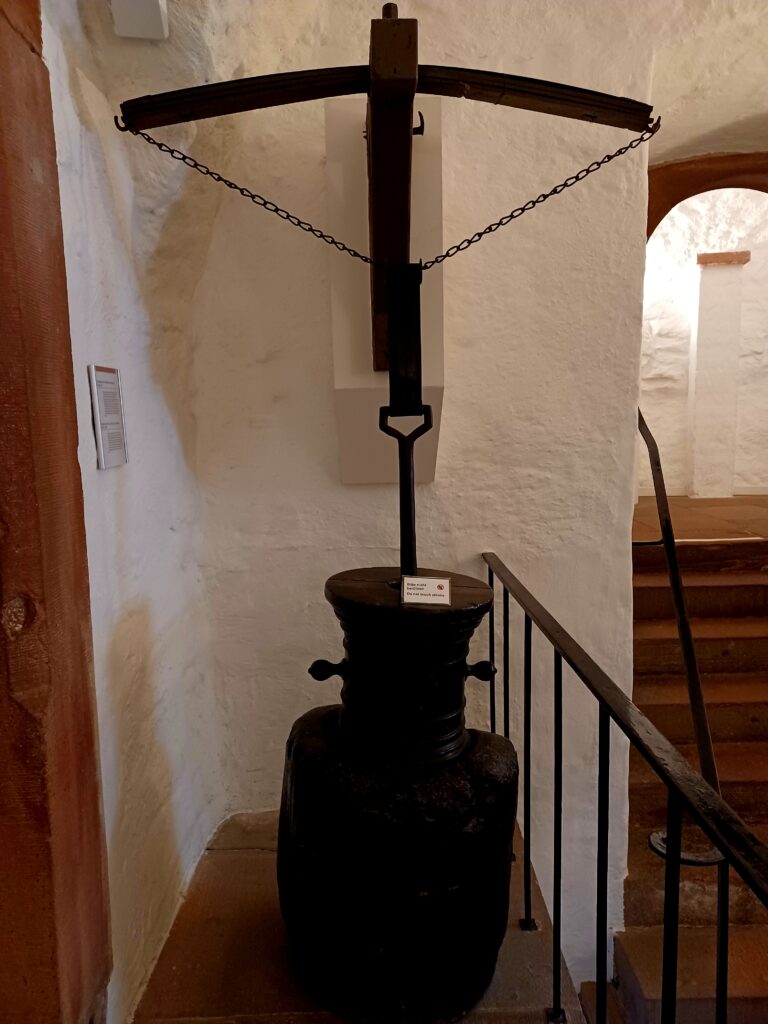
Finally, be sure to check out the Pharmacy science laboratory and its equipment, which were used from the 19th century.
Unwind at Schlossgarten (Castle gardens)
The last stop on our Schloss Heidelberg tour is the beautiful Schlossgarten (Hortus Palatinus) that was added to the castle complex in the 17th century. It was the last project commissioned by the Prince Electors, but was never completed.
Today Schlossgarten is perfect for taking a break on the grass, having a picnic, and enjoying the panoramic view of Heidelberg’s Altstadt (Old Town), the Neckar river, and the Alte Brücke (Old Bridge).
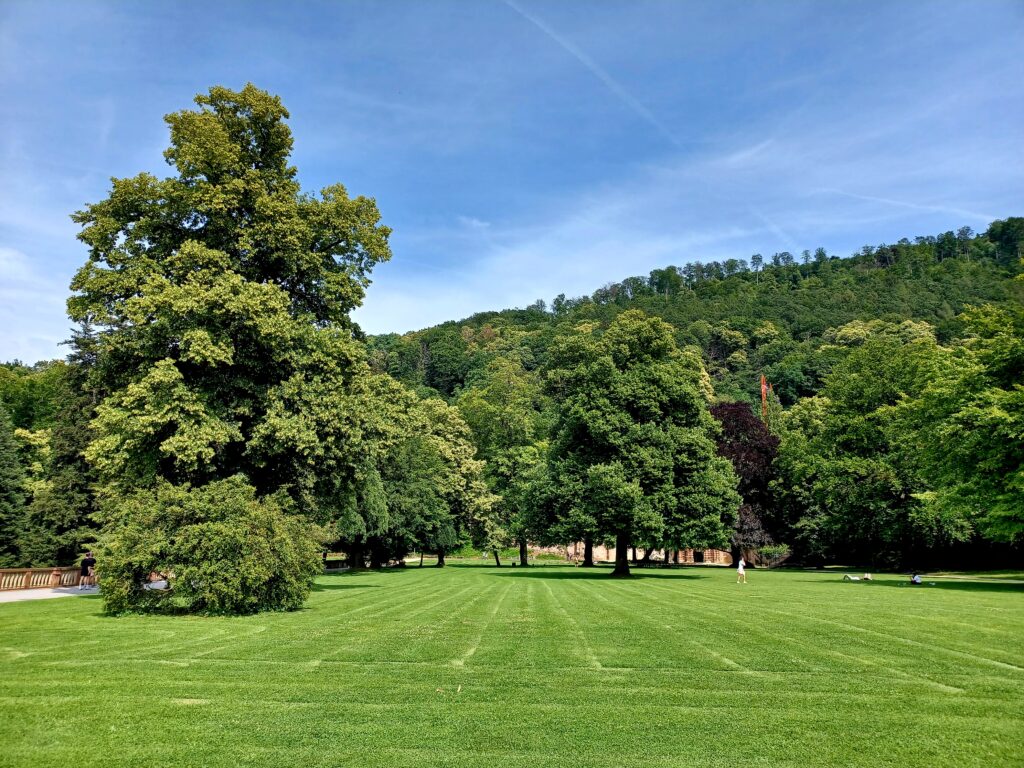
Go Up to Königstuhl (King’s Seat) Viewpoint
Next, hop back on the funicular and transfer at Molkenkur station to the upper funicular. It is more than 100 years old and takes you to Königstuhl Viewpoint in just a few minutes. At 567 meters (1,860 ft), Königstuhl is the highest mountain of the “Small Odenwald” terrain.
Most people come here for breathtaking views of Heidelberg, the Neckar valley, and the Rhine Plain. But you can also sit on the actual Königstuhl, visit a falconry or the Fairy Tale Theme Park, and learn about astronomy at the National Observatory. There are lots of hiking trails as well.
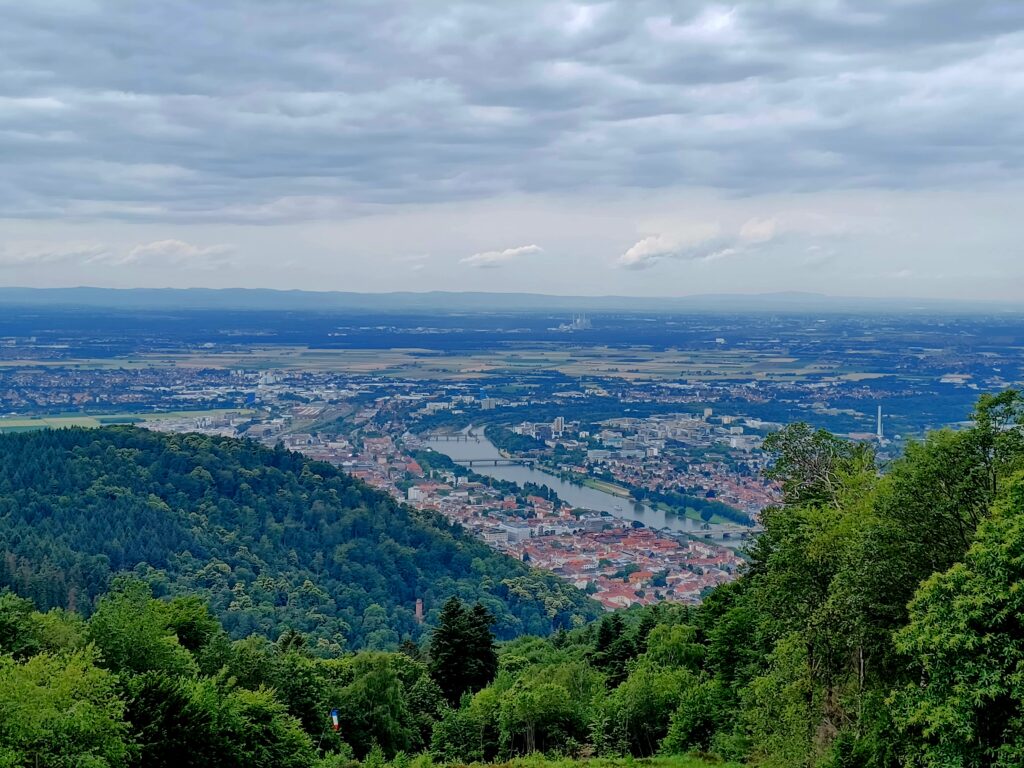
If you’d like to visit Schloss Heidelberg complex and Königstuhl Viewpoint, I recommend buying the Panorama Ticket at Kornmarkt Station (at 16 EUR roundtrip). It includes all of these attractions.
Another attraction you wouldn’t expect here is the Monument to the Battle of the Nations in Leipzig, Germany in 1813. After Prussia and Russia (supported by Austria, Sweden, and England) won against Napoleon’s troops, there were big celebrations all over Southwestern Germany.
After living in peace for one year, 5,000 Heidelbergers made their way up to Königstuhl to celebrate this victory in October 1814.
Eat Lunch at Hans im Glück Burger Grill & Bar
Address: Hauptstrasse 187, 69117 Heidelberg, Germany
After all this excitement, let’s grab some food! I had lunch at Hans im Glück Burger Grill & Bar in the heart of Heidelberg’s Altstadt. You can sit outside or inside the cozy restaurant area and their menu features many vegan and vegetarian dishes.
I went for the vegan Abenteuerlust Burger (falafel patty, grilled veggies, beets, and garlic mayo) with fries and a Peach lime ice tea. Everything was very yummy and the bill was less than 20 EUR, so this filling meal was quite easy on the wallet!
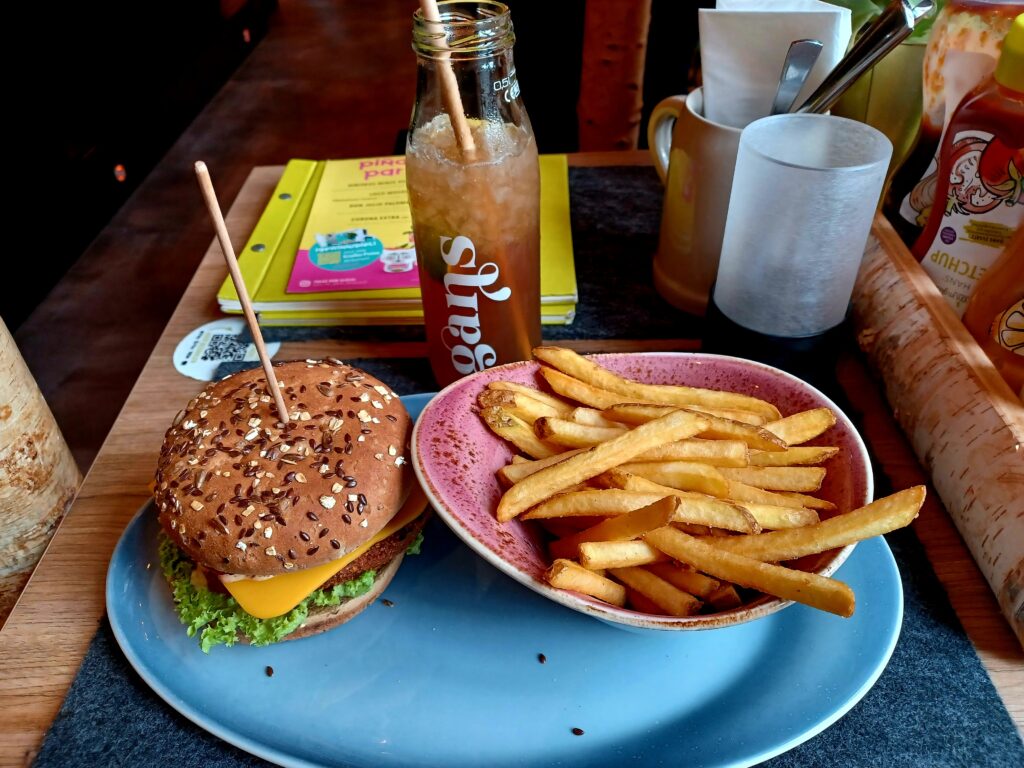
Admire the Alte Brücke, Brückentor & Brückenaffe
Address: Alte Brücke, 69117 Heidelberg, Germany
Another iconic Heidelberg landmark is the Alte Brücke (Old Bridge). It consists of Neckar Valley sandstone and Elector Karl Theodor completed it in 1788. This Baroque bridge links the Old Town with the Neuenheim neighbourhood on the opposite side of the Neckar river.
Eight wooden bridges already stood here in the past, with the oldest one dating back to the 1st century CE. But war attacks, ice floes, and flooding wrecked them all, so Karl Theodor decided to build an arch bridge entirely made of stone.
Unfortunately, German troops partially destroyed the Alte Brücke on March 29, 1945, but it was quickly repaired in 1946/47. Besides, two sculptures are standing on the Alte Brücke: Elector Karl Theodor and Minerva, the Roman Goddess of Wisdom.
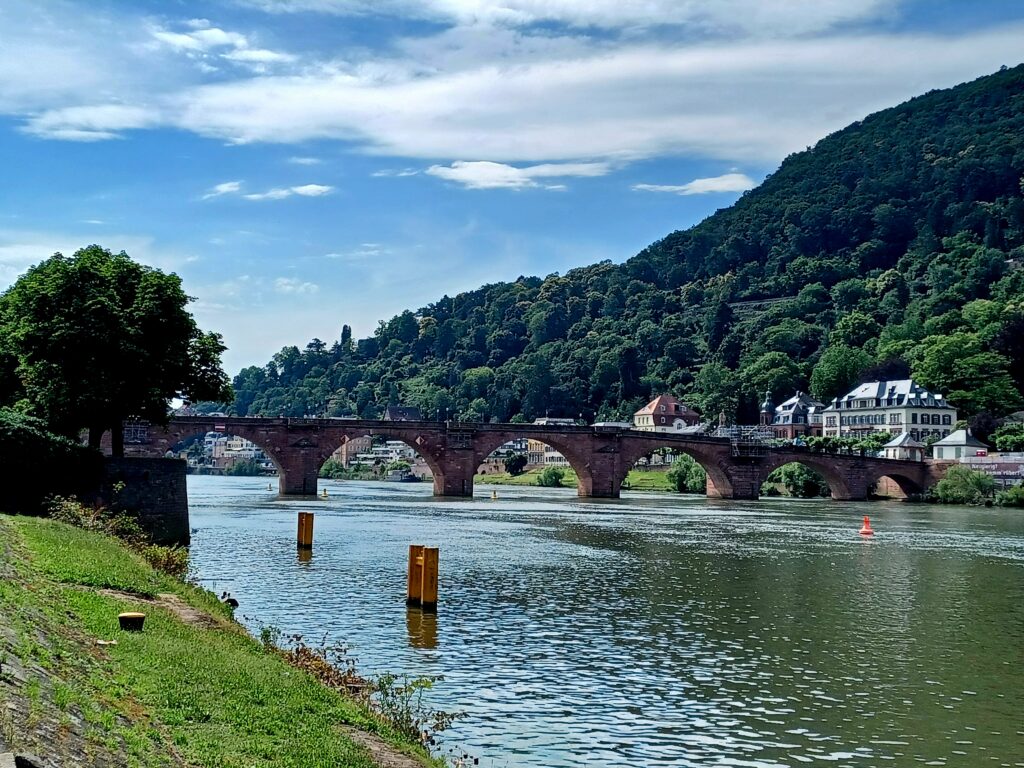
There’s no admission fee to cross the Alte Brücke.
The stunning medieval Brückentor (Bridge Gate) with the two white towers is another attraction of its own. Unlike the previous bridges, it wasn’t ruined by natural disasters or war attacks in the past.
After the current bridge was finished, the towers were used as a guardhouse and prison. Later, a small apartment was built inside the tower that was inhabited until 2004!
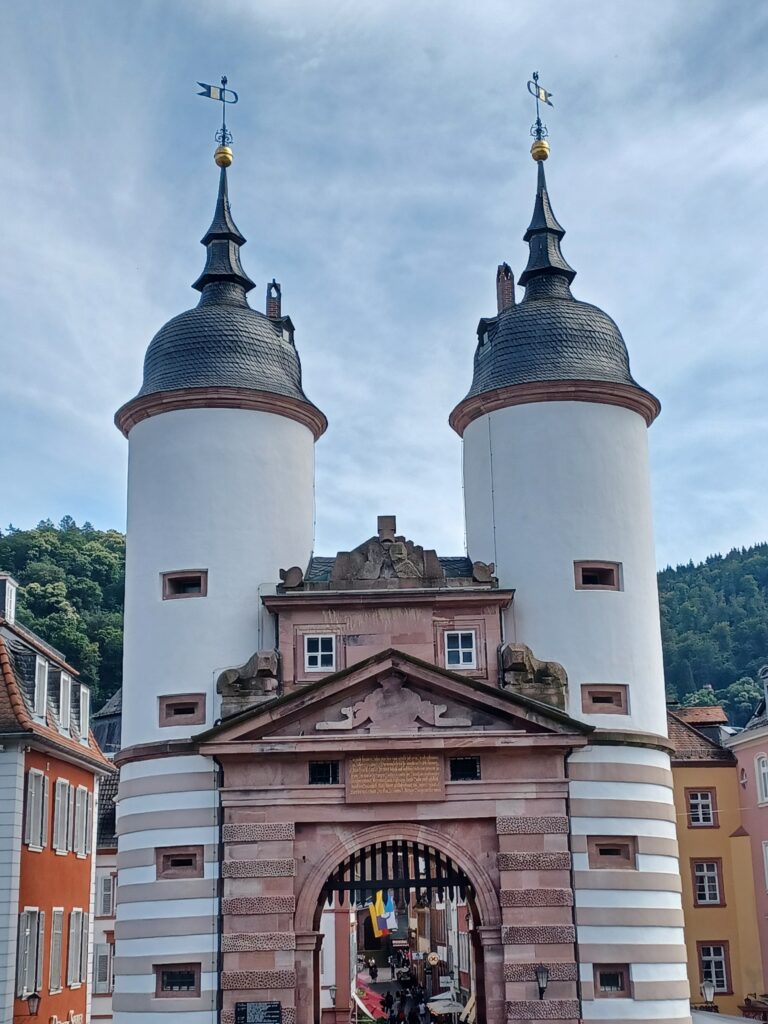
Finally, take a look at the Heidelberger Brückenaffe (Heidelberg Bridge Monkey). It’s a bronze statue that has been sitting next to the Bridge Gate since 1979.
The monkey does the sign of the horns, and if visitors touch it, they are supposed to come back to Heidelberg. It also holds a mirror, which is said to bring wealth to those who touch it.
Its predecessor was a monkey stone statue built in the 15th century that was ruined during the Nine Years’ War.
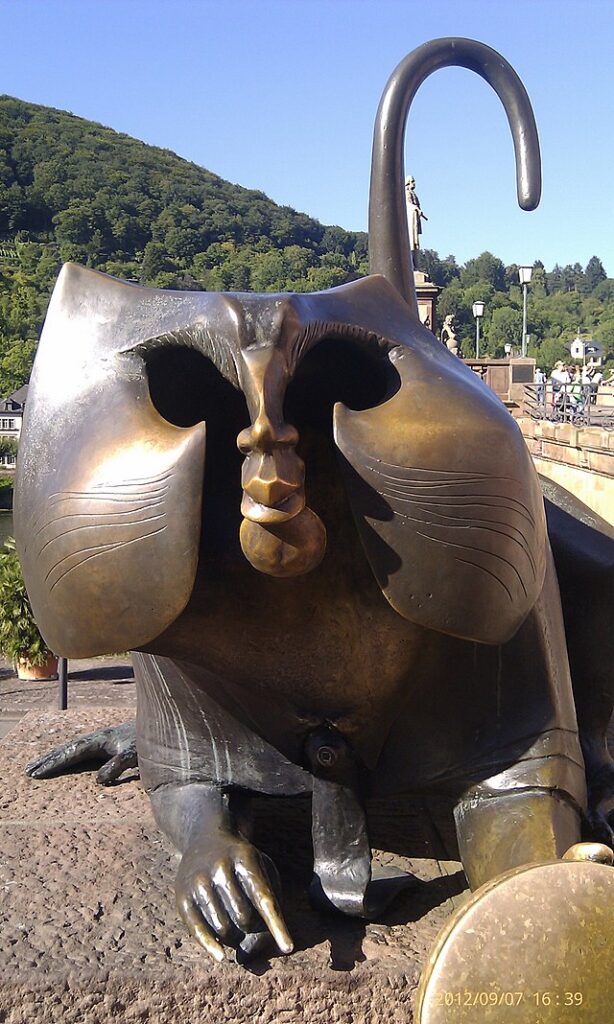
Visit the Heidelberger Studentenkarzer (Heidelberg Student Jail)
Address: Augustinergasse 2, 69117 Heidelberg, Germany
If you’re into unique and quirky museums, check out the Heidelberger Studentenkarzer! It’s next to the Old University inside a Baroque building in the university district. Established in the 1780’s, unruly students landed here for up to a month because of minor offenses from 1823 until 1914.
Some students got in trouble for missing deadlines, while others got locked up for partying, dueling, or carousing at night. Students still had to attend classes and lectures in the daytime, but had to go back to their cell once they were over.
The conditions at the Studentenkarzer were not bad. Funnily enough, many imprisoned students used this time for drinking, partying, playing cards, and leaving their mark with graffiti writings and drawings on the walls! Some students even behaved badly on purpose, so they got to experience being here at least once!
Today there are no more cells at the Studentenkarzer. But you can look inside a few rooms with sparse furniture (iron beds, wooden chairs and desks) and the graffiti drawings and writings from back then are wonderfully preserved!
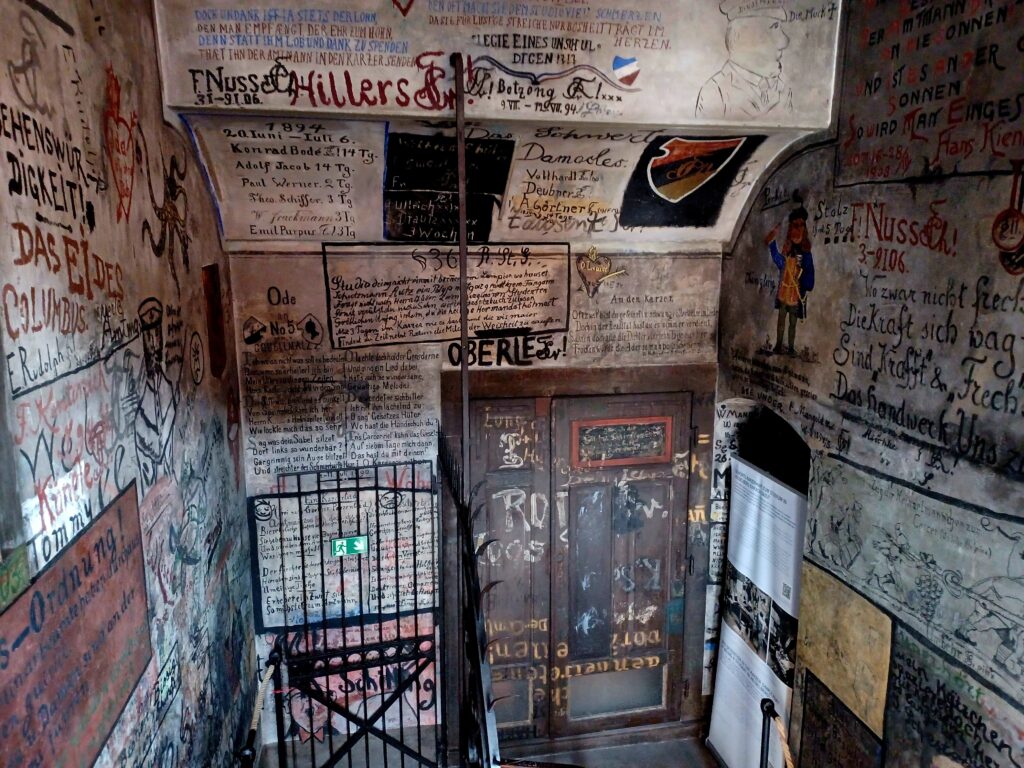
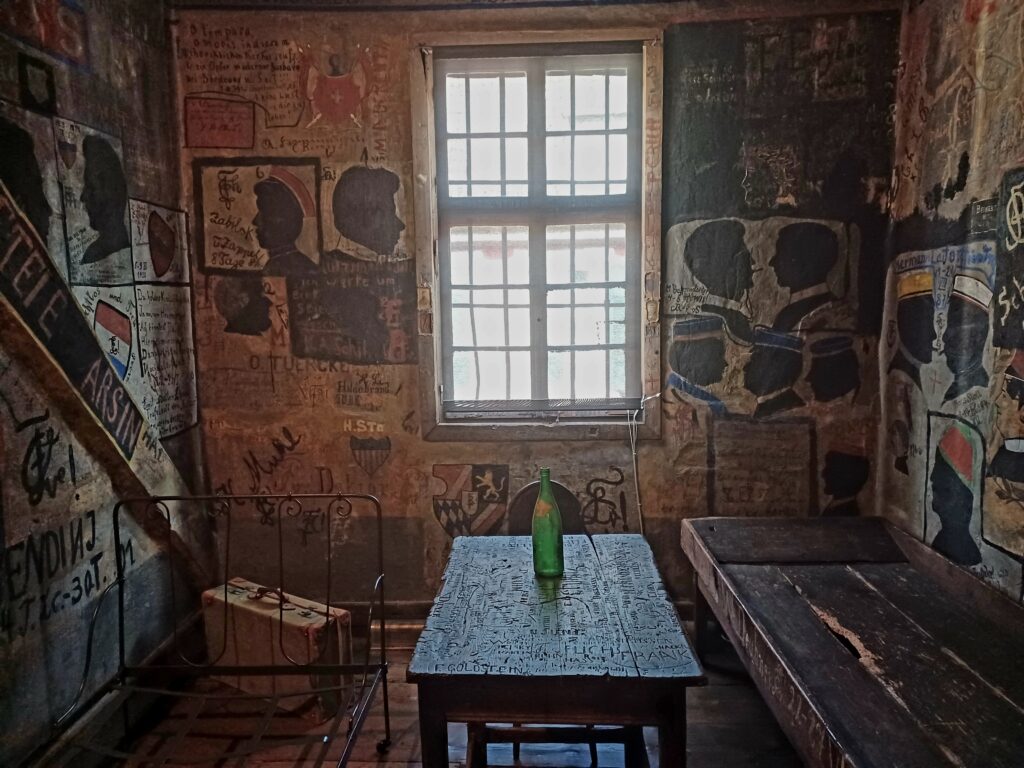
The Heidelberger Studentenkarzer is open daily from 10 am to 6 pm and the last entry is 45 minutes before closing. Admission is 4 EUR and tickets are available at the University Shop inside the same building.
Wander around Heidelberg’s Altstadt (Old Town) district and Hauptstrasse (Main Street)
The medieval Altstadt district is another highlight of Heidelberg. First mentioned in 1196, it’s the oldest part of the city. Heidelberg’s Altstadt is known for stunning historic buildings (we’ll cover a few of those next), cobblestone streets, shops, (outdoor) restaurants, cafés, and bars!
Some unmissable spots of Heidelberg’s Altstadt are Marktplatz (Market Square) with the city’s Rathaus (City Hall) and Kornmarkt with its iconic Madonna fountain sculpture.
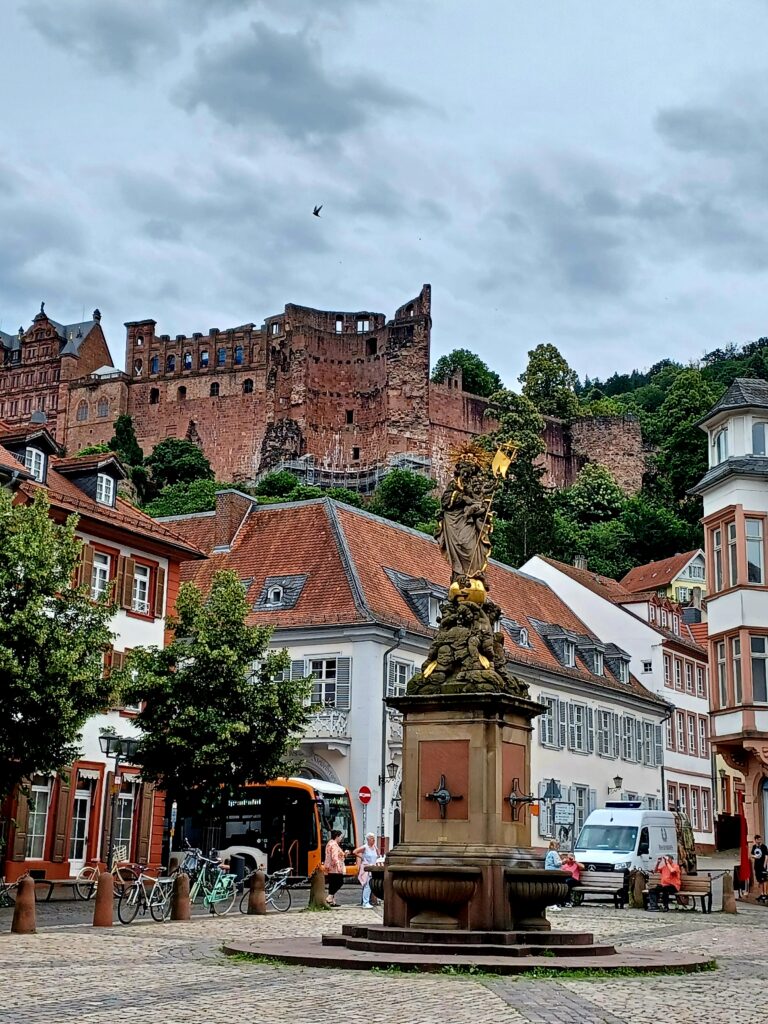
Another spot you cannot miss is Hauptstrasse, a vibrant pedestrian-only street that runs from one end of the Altstadt to the other.
At approximately 1.8 km (1.11 miles), it’s one of the longest and oldest pedestrian streets in Europe. Besides, Hauptstrasse is a paradise for shopping fans. Whether you feel like buying candy, books, touristy souvenirs, clothes, decorative items, or tea, Heidelberg’s Hauptstrasse has it all!
So it’s no surprise that this area draws tourists from around the world. If you’re worried about missing anything, booking a walking tour of Heidelberg’s Hauptstrasse and the Altstadt is a great idea! Or if you need a break from the crowds, walk around the side streets of Hauptstrasse for a bit.
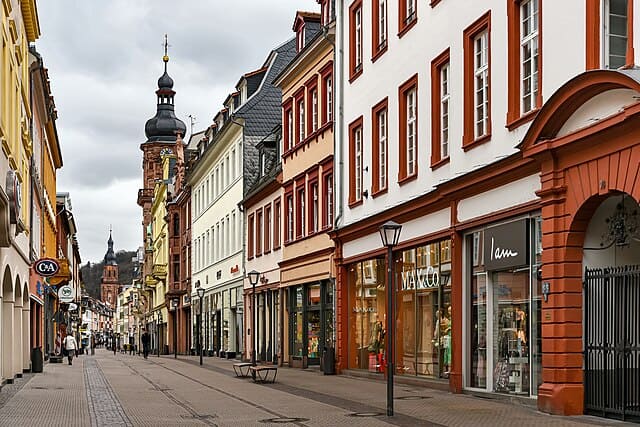
Admire the Hotel Zum Ritter (Hotel of the Knight) & Heiliggeistkirche (Church of the Holy Spirit)
There are some cool historic buildings on or near Hauptstrasse as well!
One example is Hotel Zum Ritter St. Georg (Hauptstrasse 178, 69117 Heidelberg, Germany). This historic town house has stood here since 1592 and has been an inn for more than 300 years. Besides, it’s the only town house in Heidelberg that wasn’t ruined by fire in 1693 during the Nine Years’ War.
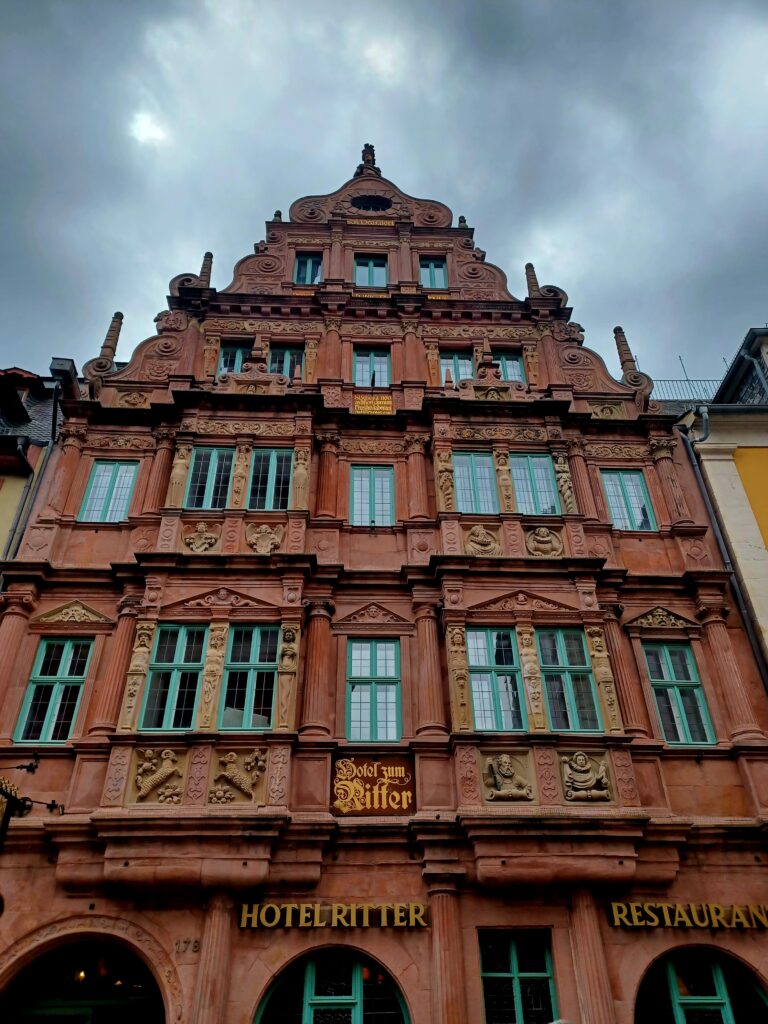
Also, you cannot miss the impressive Heiliggeistkirche right across the street. This Gothic style church dates back to 1398. Its predecessor was built in the 13th century, but fell victim to a fire in the early 14th century.
Heiliggeistkirche switched between being a Catholic and Protestant church in the 16th/17th century. It was even split in the middle for 200 years, so religious services could happen for both faiths at the same time!
In 1936, Heiliggeistkirche became a church for just Protestants again.
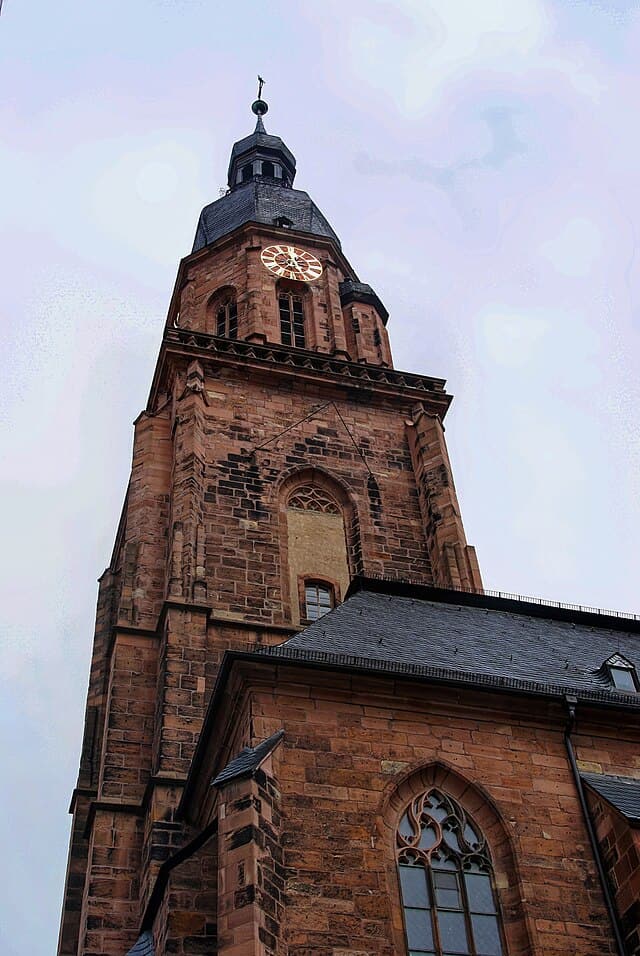
Other (Free!) Things to do in Heidelberg
If you’d like to explore more Heidelberg attractions, here are a few suggestions:
Philosophenweg (Philosophers’ Walk)
Philosophenweg is a scenic 2 km (1.24 miles) loop forest pathway that starts at the Neuenheim district on the right side of the Neckar River. A great view of the city and Heidelberg Castle is guaranteed while walking this winding path.
According to legend, university professors and philosophers have walked here a lot, maybe for inspiration. That’s why it’s called Philosophenweg and it takes about an hour to complete this pathway.
The climate is more temperate than in the rest of the valley. So in the summer, you can see plants usually growing in the Mediterranean, like lemon trees, cherries, pomegranates, and palm trees!
There’s also the Philosophengärtchen (Philosophers’ Garden), a great spot to relax and enjoy the view. Finally, you can look at the monument of Joseph Freiherr von Eichendorff, one of the main writers of Romanticism.
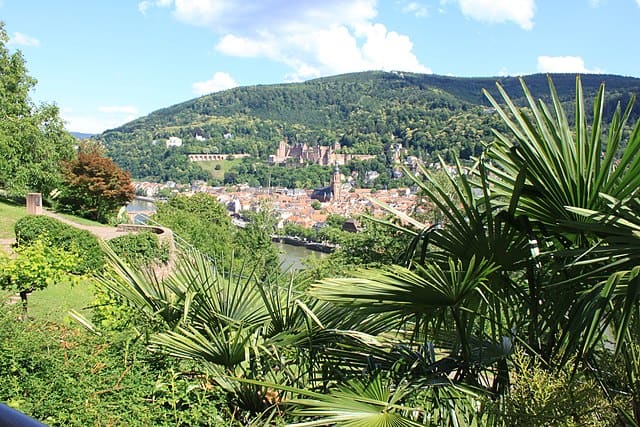
Heiligenberg (Hill of Saints)
Not too far from Philosophenweg and on the opposite river side from Schloss Heidelberg is Heiligenberg. This 439 m/1,440 ft hill summit offers another awesome view of Heidelberg and its surrounding areas.
Since the 5th century BC, this site has been famous for the remains of Celtic, Roman, and Medieval times.
For example, there are the ruins of a Celtic fortress, as well as two impressive monastery ruins of St. Michael and St. Stephan from the 11th century to look at.
Heidelberg Thingstätte (Thing Site)
The Heidelberg Thingstätte is an open-air amphitheatre next to Heiligenberg. It’s an example of architecture built during the Third Reich and was used for Nazi propaganda events. Its builders, who created the Thingstätte in 1934/35, got inspired by the building style of ancient Greek theatres.
There was room for 8,000 sitting and 15,000 standing visitors. But soon, the Nazis lost interest in this site, so it was barely used during World War II and then abandoned. Today Heidelberg Thingstätte is a Cultural monument that everyone is free to visit.
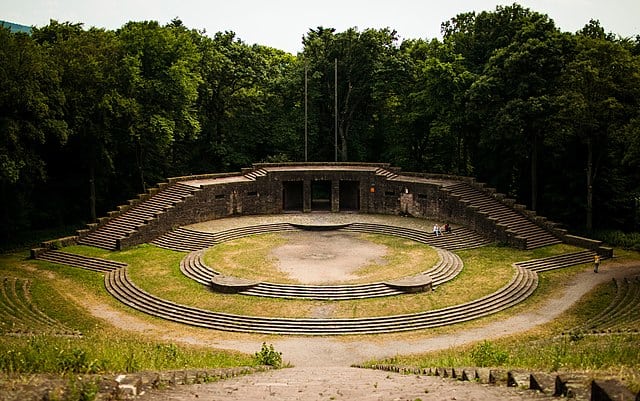
How to Get to Heidelberg on Public Transit
As a popular tourist destination, it’s pretty easy to get to Heidelberg on public transit.
For many international visitors, Frankfurt (Main) Airport is their gateway to Germany. It’s only a 60-minute to 75-minute train ride from Frankfurt Central Station to Heidelberg Central Station, so it’s a perfect daytrip destination!
It’s a 15 to 20-minute bus or tram ride from Heidelberg Central Station to the Altstadt district. Once you arrive at the Altstadt, almost all attractions are within a short walking distance.
Flixbus goes from Frankfurt to Heidelberg as well and the prices are often cheaper than train tickets.
Other popular cities in Germany, like Munich or Nuremberg, are 3 to 3.5 hours from Heidelberg by train.
The Best Time to Visit Heidelberg
The City of Heidelberg is nice to visit year-round.
It’s perfect to go to Heidelberg in the spring or fall. That’s when temperatures are mild and tourist crowds are at a minimum, especially on weekdays.
While Heidelberg is busiest with tourists in the summer, this is the season for cool outdoor festivals (e.g. the Heidelberger Schlossfestspiele). Besides, bars as less busy, thanks to many university students having the summer off.
During Christmas time, check out the magical Weihnachtsmarkt (Christmas Market) in Heidelberg’s Altstadt district. Here you can buy locally made gifts, look at the many Christmas lights, and try some Glühwein (mulled wine) and Lebkuchen (gingerbread).
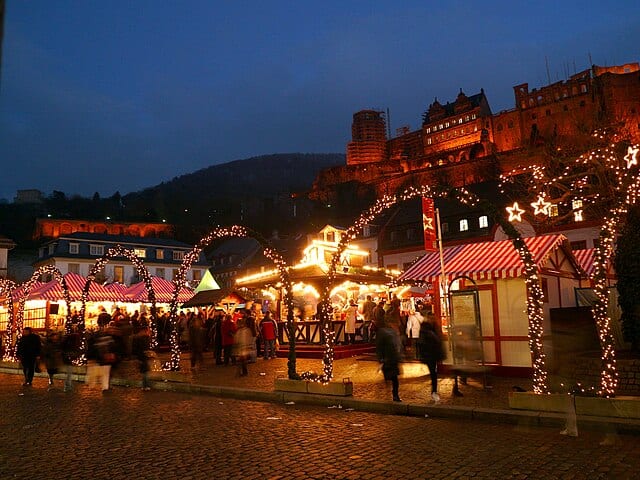
Conclusion
As you can see, there are many ways to make One Day in Heidelberg, Germany special! Whether you like historic castles and bridges, cool museums, great restaurants, shopping, or stunning natural attractions, Heidelberg surely will knock your socks off!
My favourite spots in Heidelberg are the German Apothecary Museum, the Student Jail, and the breathtaking view of Heidelberg and its surroundings from the Castle Garden!
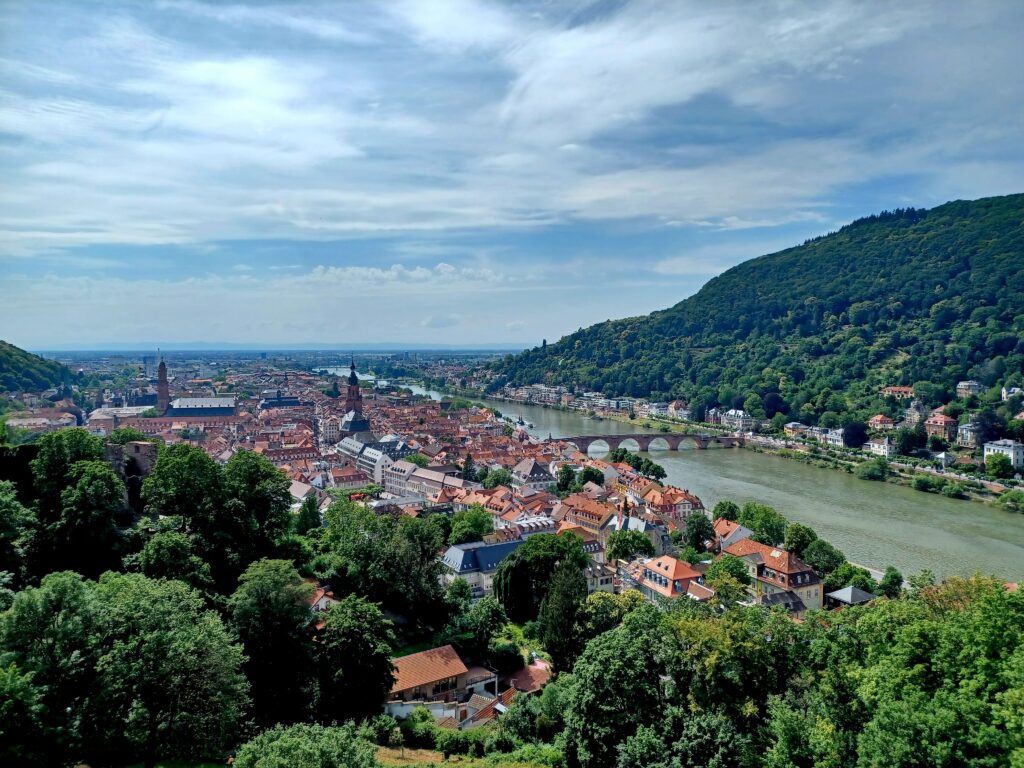
I didn’t find Heidelberg expensive, as the admission fees to some attractions were quite budget-friendly. Besides, other attractions in this guide (e.g. the Alte Brücke and Philosophenweg) are free!
Since it’s easy to get here by bus or train from other cities in Germany, the charismatic city of Heidelberg is perfect to visit for a day. But if you’d like to stay longer, there are tons of accommodations for every budget to stay at as well!
Here’s a map of Heidelberg’s awesome attractions:
**Ich hab’ mein Herz in Heidelberg verloren (I Lost my Heart in Heidelberg) is a famous German folk song composed by Fred Raymond in 1925. In fact, it remains Heidelberg’s Theme Song until today!
Traveling around Germany for a while? Then check out these posts:
The Ultimate Travel Guide to Bamberg, Germany
How to Spend 24 Hours in Berlin, Germany
- 9 REASONS TO VISIT LEIPZIG, GERMANY FOR A DAY - April 7, 2025
- ONE DAY IN ANCONA, ITALY: THE 6 BEST THINGS TO DO IN 2025 - February 28, 2025
- THE ULTIMATE SOUTH COAST OF ICELANDITINERARY: THE PERFECT DAY TRIP FROM REYKJAVIK - February 1, 2025

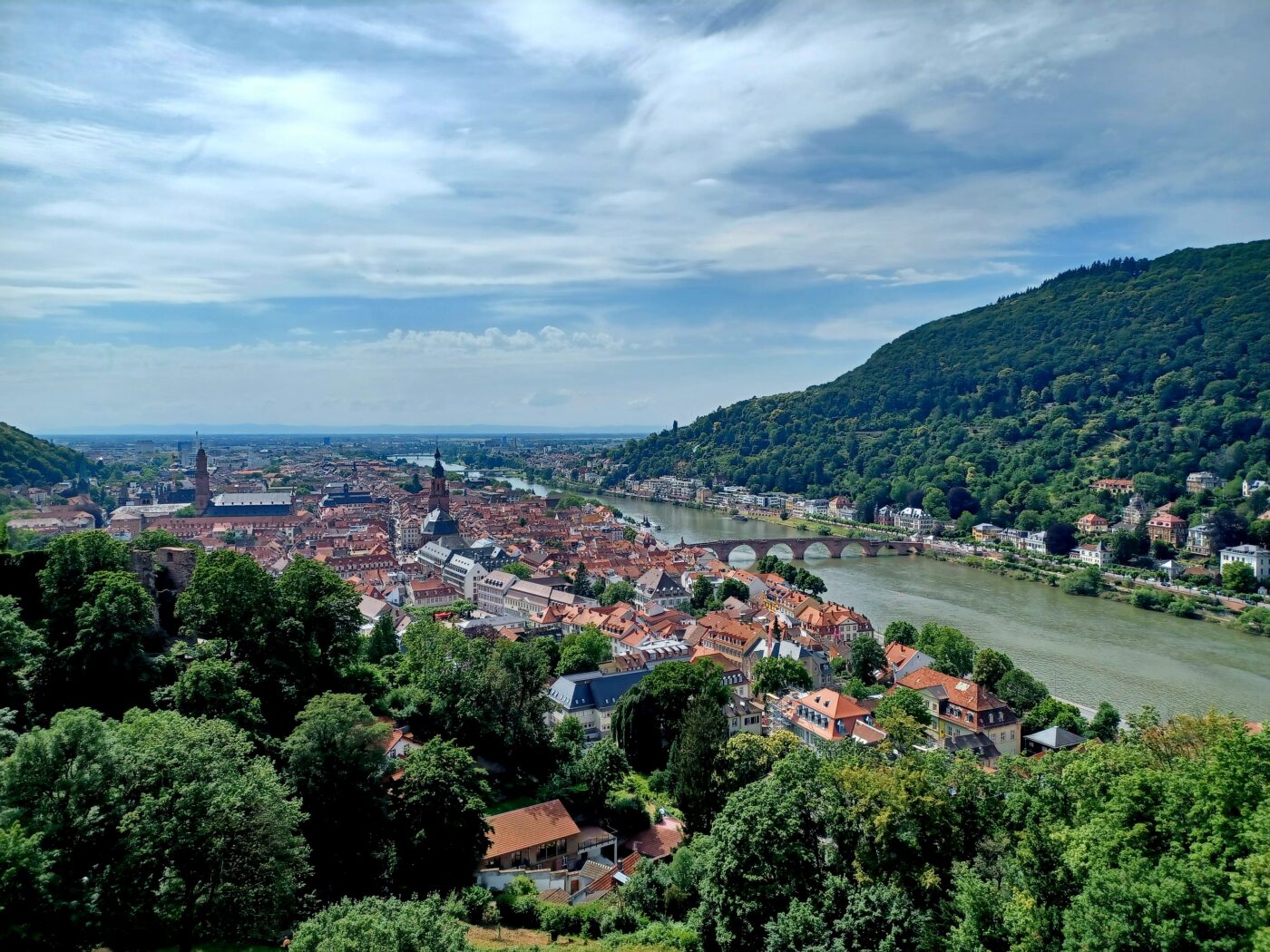

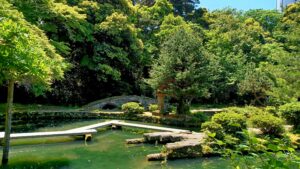
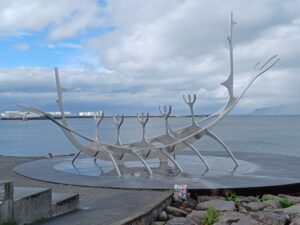
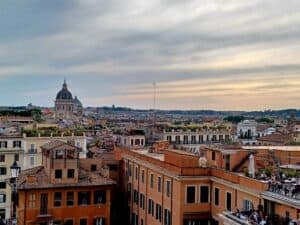
Leave a Reply